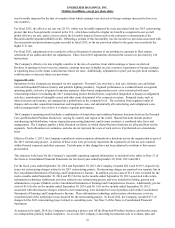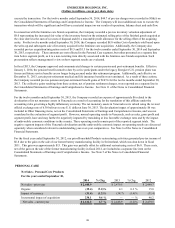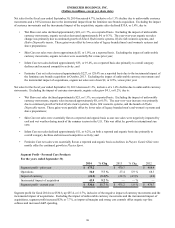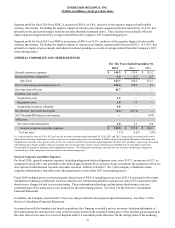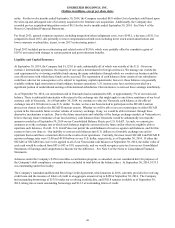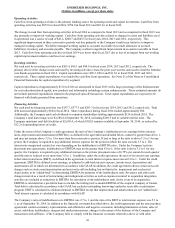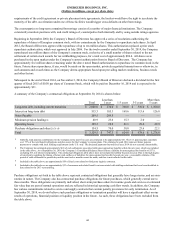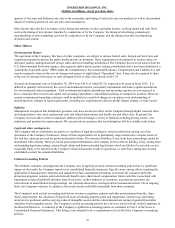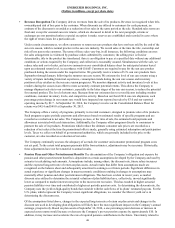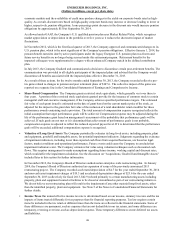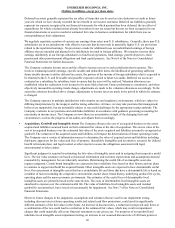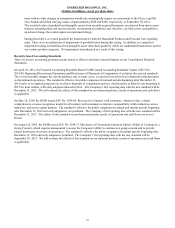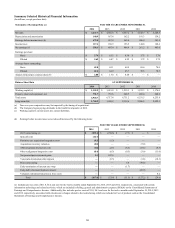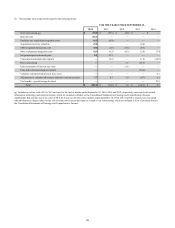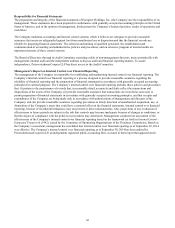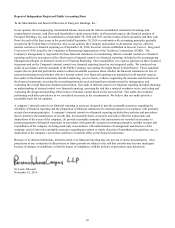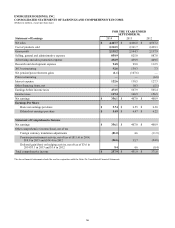Energizer 2014 Annual Report Download - page 50
Download and view the complete annual report
Please find page 50 of the 2014 Energizer annual report below. You can navigate through the pages in the report by either clicking on the pages listed below, or by using the keyword search tool below to find specific information within the annual report.
ENERGIZER HOLDINGS, INC.
(Dollars in millions, except per share data)
currency. The SICAD II program does not supersede the Cadivi/Cencoex for essential imports (currently at 6.30 bolivars per
U.S. dollar) nor SICAD I (equal to 12.00 bolivars per U.S. dollar as of September 30, 2014). Thus far, the Company has not
been invited to participate in the SICAD I auction process nor chosen to utilize the SICAD II auction system. There is
substantial uncertainty with respect to the exchange rate that might apply to any future remittance of our local currency cash in
Venezuela. As of September 30, 2014, the Company continues to value its Venezuela cash balance at the official exchange rate
of 6.30 bolivars to one U.S. dollar. Whether we will be able to access or participate in either SICAD system in the foreseeable
future or what volume of currency exchange, if any, we would be able to transact through these alternative mechanisms is
unclear. We continue to monitor this situation including the impact that continued restrictions on the ability to exchange local
currency for U.S. dollars may have on our future business operations, including our ability to import products from other
Energizer affiliates for sale in the Venezuela market and how such restrictions or other future developments may impact our
operating results in Venezuela. See Note 6 of the Notes to Consolidated Financial Statements.
In addition, the Company has affiliates located in certain developing markets such as Argentina, which may be susceptible to
greater volatility of inflation and currency exchange rates, as well as government pricing and import controls. While these
affiliates are not considered material in relation to the consolidated company as a whole, there could be negative impacts to
operating results in certain markets, if inflationary pressures, exchange volatility and government controls negatively impact the
Company's ability to operate effectively and profitably.
Commodity Price Exposure
The Company uses raw materials that are subject to price volatility. At times, the Company has used, and may in the future use,
hedging instruments to reduce exposure to variability in cash flows associated with future purchases of certain materials and
commodities. At September 30, 2014, there were no open derivative or hedging instruments for raw materials or commodities.
Interest Rate Exposure
At September 30, 2014 and 2013, the fair market value of the Company's fixed rate debt is estimated at $2,056.5 and $2,262.3,
respectively, using yields obtained from independent pricing sources for similar types of borrowing arrangements. The
estimated fair value of debt is greater than the carrying value of the Company's debt by approximately $58 and $124 at
September 30, 2014 and 2013, respectively. A 10% decrease in interest rates on fixed-rate debt would have increased the fair
market value by approximately $42 and $47 at September 30, 2014 and 2013, respectively. See Note 13 of the Notes to
Consolidated Financial Statements for additional information regarding the Company’s debt.
Through December 2012, the Company had specific interest rate risk with respect to interest expense on the Company's former
term loan, which was repaid by the end of the first quarter of fiscal 2013. As a result, the interest rate swap agreement in place
to hedge this specific risk was settled at that time for a $0.3 loss. This loss was included in interest expense in the Consolidated
Statements of Earnings and Comprehensive Income. At September 30, 2014, the Company had $289.5 of variable rate debt
outstanding, which was primarily outstanding borrowings under the Company's revolver and receivable securitization program.
Stock Price Exposure
The Company holds a share option with a major financial institution, which matured in November 2014, to mitigate the impact
of changes in certain of the Company’s unfunded deferred compensation liabilities, which are tied to the Company’s common
stock price. The fair market value of the share option held by the Company was $5.6 and $7.7 as included in other current
assets at September 30, 2014 and 2013, respectively. The change in estimated fair value of the total share option for fiscal 2014
and 2013 resulted in income in both periods of $12.3 and of $15.5, respectively, and was recorded in SG&A. Period activity
related to the share option is classified in the same category in the Consolidated Statements of Cash Flows as the period activity
associated with the Company’s unfunded deferred compensation liability, which was in cash flow from operations.
Seasonal Factors
The Company's Household Products segment results are typically impacted in the first quarter of the fiscal year by the
additional sales volume associated with the December holiday season, particularly in North America. First quarter sales
accounted for approximately 31% of total Household Products net sales in fiscal 2014, approximately 32% in fiscal 2013 and
approximately 30% in fiscal 2012. In addition, natural disasters, such as hurricanes, can create conditions that drive
exceptional needs for portable power and may result in a short term increase in battery and lighting products sales. This was
recently evident as the Company estimates that incremental volume in response to Hurricane Sandy added approximately $18 to
sales in the first fiscal quarter of 2013.
Customer orders for the Company’s sun care products are highly seasonal, which has historically resulted in higher sun care
sales in the second and third quarters of our fiscal year and lower sales in the first and fourth quarters of our fiscal year. As a
result, sales, operating income, working capital and cash flows for the Personal Care segment can vary significantly between
46



